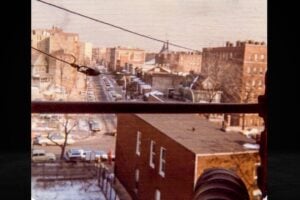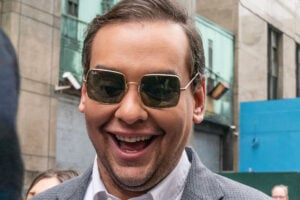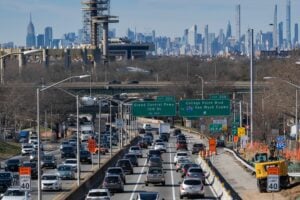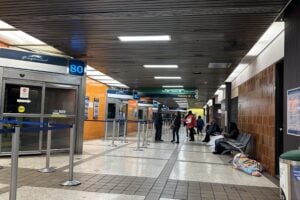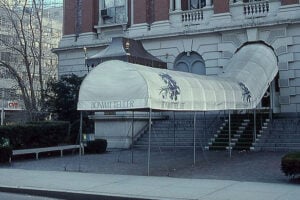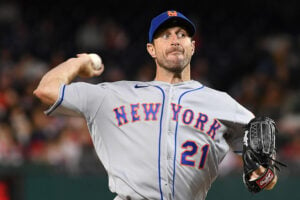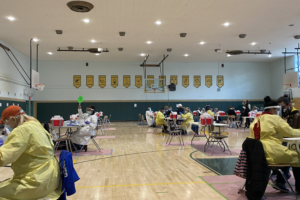
Photo: New York World-Telegram and the Sun staff photographer: Fernandez, Orlando, photographer., Public domain, via Wikimedia Commons
John Lindsay was a very memorable New York politician. He represented his home city and state for parts of three decades. Even though he was somewhat controversial, he never backed down from his opponents. Lindsay strived to make his city a better place to live and work in. Lindsay was born on November 24, 1921 on West End Avenue in New York City. His parents were Florence Eleanor (Vliet) Lindsay and George Nelson Lindsay, who were of Dutch and English heritage. George had long successful careers as an investment banker and a lawyer. John attended the independent Buckley School through ninth grade, the college prep boarding academy St. Paul’s School in Concord, New Hampshire and Yale University.
Young George finished his initial degree in 1943, and soon joined the Army during World War II. He quickly rose to the rank of lieutenant and received a total of five battle stars for his actions during several landings in the Asiatic-Pacific Theater and the Allied Invasion of Sicily. He graduated from Yale School of Law and accepted a position at the Webster, Sheffield, Fleischmann, Hitchcock & Chrystie firm in New York City the following year. Lindsay would eventually become a partner in the firm by 1953.
John married Mary Anne Harrison in 1949, the same year that he passed the bar exam and began his legal career. The couple first met at the wedding of Alexander Ellis II and Nancy Walker Bush in 1946. John and Mary would go on to raise a son and three daughters.
Lindsay’s political interests were evident when he helped to create the Youth for Eisenhower Club in 1951. In 1952, he was named president of the New York Young Republican Club. Three years later, John became the executive assistant for Attorney General Robert Brownell at the U.S. Department of Justice.
In 1959, John was elected to the U.S. House of Representatives. There he represented New York’s 17th District. The district is home to Greenwich Village and the Lower East Side and the Upper East Side of the borough of Manhattan. Despite running as a Republican, he soon started what would later become a very liberal voting history. He wasn’t afraid to cross party lines and speak up for what he believed in. Lindsay supported the development of a National Foundation for the Arts and Humanities and the United States Department of Housing and Urban Development. He also agreed with federal funding being earmarked for Medicare and education. John was one of only two votes that were against legislation that would have condemned both pornography and Communism, after realizing that both industries were essential industries in his district. He was also the sole opponent of a bill that would have allowed the Postmaster General to withhold mail that may be considered obscene.
Lindsay ran for mayor of New York City in 1965. He ran as the Republican candidate against Conservative William F. Buckley Jr. and Democrat Abraham D. Beame. John won the election easily. Political commentator James Murray Kempton observed during the campaign that more and more people were favoring Lindsay because “he is fresh and everyone else is tired.” That quote eventually became the unofficial motto for John’s campaign that year.
John ran into difficulties as soon as he took office on January 1, 1965. Mike Quill and his Transport Workers Union of America chose that day to start a shutdown of all bus and subway services in New York City. Lindsay initially took the issue in stride, but soon realized that he had to make some tough decisions. To make up for the loss of revenue, he added a commuter tax for non-residents who worked in New York City. He also asked the state legislature to raise water rates and add a new municipal income tax for people who lived in the city.
Lindsay experienced a nine-day sanitation strike and a three day strike on Broadway in 1968. All of this happened while he was working on attempting to resolve issues with the New York City school system. John granted three city school boards complete control over how their schools were operated. The intention was to allow the respective communities to have more input and influence into how these schools were run. However, this action was scrutinized by the United Federation of Teachers, which was the city’s teachers union.
The federation saw the move as an attempt to eradicate the long-standing union. They preferred working with the same unit that they had always negotiated with, and didn’t like the idea of having to interact with 33 different school boards. The United Federation of Teachers began the first of several lengthy strikes in the city after a few teachers from one of the newly independent school districts had been fired. The union stated that the teachers who were dismissed were not given due process. The strikes lingered for several months and often had racial overtones, as Jewish teachers and school administrators sided against Puerto Rican and African American students and their families. These racial tensions lasted for many years long after the strikes were settled. John would later admit that the situation was one of his biggest regrets from his mayoral term.

Photo: New York World-Telegram and the Sun staff photographer: Albertin, Walter, photographer., Public domain, via Wikimedia Commons
Lindsay worked diligently to help improve race relations in his city. He was a part of the Kerner Commission, also known as the National Advisory Commission on Civil Disorders. President Lyndon B. Johnson created the group in 1967 following several urban riots that occurred across the nation. John went to Harlem to seek peace following one of the many riots that happened after Martin Luther King Jr’s death in 1968. He apologized to the crowd, and said that he was going to take actions to reduce poverty in the city. His calm demeanor and willingness to help and listen to his constituents was a major contributing factor in ending looting, violence and unrest in New York City that year.
Fifteen inches of snow fell on February 10, 1969 during a blizzard that would later be known as the “Lindsay Storm.” Several of his opponents bemoaned the fact that Manhattan neighborhoods were cleared first while the roads and streets of Queens and other neighborhoods remained difficult to navigate for as much as a week afterwards. John visited Queens, where he encountered a fair amount of supporters and critics. Some skeptics thought that the mayor didn’t really care very much about the city’s poor and middle class citizens.
Lindsay was up for re-election a few months later. He lost the Republican mayor primary to New York state senator John J. Marchi, but ran as a member of the New York Liberal Party. John campaigned against Marchi and Democratic candidate Mario Procaccino. He won a second term as mayor, thanks in large part to the support of many residents from Manhattan, Brownsville, Brooklyn Heights, Harlem, Kew Gardens, South Bronx and Forest Hills neighborhoods.
Another riot broke out in May 1970, this time near New York City Hall at the intersection of Broad Street and Wall Street. Around a thousand high school and college students who were protesting the Vietnam War, Cambodian Campaign and the recent shootings at Kent State University clashed with around two hundred construction employees from the AFL-CIO labor union. The mayor complained about the police department’s failure to act in a timely manner to prevent people from being injured during the incident. Police department labor leaders responded by criticizing Lindsay for “undermining the confidence of the public in its Police Department by his statements.” They stated that the delay in response was due to uneven guidance and not enough readiness from the mayoral office under previous administrations. Protests by white-collar workers, construction workers and longshoremen opposing the mayor would ensue later that month.
Reports of police corruption also came to light in 1970 after a New York Times article printed claims that were made by New York City Police Department Patrolman Francesco “Frank” Serpico. Lindsay created the Knapp Commission to Investigate Alleged Police Corruption as a result. Public hearings began in October 1971 and official reports and recommendations were released the following year. Many police officers turned against John because of his involvement in this issue. Lindsay later worked to convert the New York City Civil Complaint Review Board from an agency that was run by the police department into an organization whose board was primarily run by residents of the city. He gave people more power and influence into how their police department was run and impacted their communities.
Lindsay endured a two-day strike by New York City sewage treatment plant and drawbridge operators in the summer of 1971. However, that wasn’t the biggest event for him that year. John and his wife decided to end their affiliation with the Republican party after almost two decades as they moved over to the Democratic Party. He stated that “this step recognizes the failure of 20 years in progressive Republican politics” in explaining the change. He also began a short run for the Democratic presidential nominee in 1972. His efforts ended after he placed fifth in the Florida primary behind Alabama’s George Wallace, Minnesotan Hubert H. Humphrey, and Washington’s Scoop Jackson.
John’s second term as mayor ended at the close of 1973. Although he tried to become nominated as the Democratic Senate candidate for New York in 1980, his political career was essentially over after he left the New York City mayor’s office. Lindsay turned his attention to entertainment. He served as a guest host and commentator for Good Morning America on ABC. John acted in the movie Rosebud and appeared on the Tony Awards broadcast in 1975. His novel The Edge was published in 1976 after his two non-fiction memoirs had already been released.
Lindsay’s health started to decline in his later years. He suffered several strokes, a heart attack and was diagnosed with Parkinson’s Disease. He returned to the legal profession after his political career ended, but was left with skyrocketing medical bills and no health insurance after the two firms that he worked closed their doors for good. John was eight years shy of qualifying for a city pension. In 1996, Mayor Rudy W. Guiliani named Lindsay to a couple of primarily ceremonial positions so that he could receive the health care coverage that he needed. John and Mary moved into a retirement village in Hilton Head Island, South Carolina in 1999. John Lindsay passed away on December 19, 2000 after fighting pneumonia and Parkinson’s Disease.
Investor Carter Bales, New York state senator Carl McCall and future New York City mayor Mario Cuomo are just a few people who got their start in politics during John Lindsay’s mayoral term. Parks in Brooklyn and Manhattan were renamed in his honor and Yale Law School announced a Lindsay memorial fellowship in 2000 to recognize their distinguished alumni.
Whether people loved him or hated him, it was hard to ignore John Lindsay’s impact on New York City. He wasn’t particularly known for his patience or his subtlety, but you always knew where he stood on important issues. The city’s 107th mayor left a lasting legacy that dozens of current and aspiring politicians have admired for decades and will undoubtedly continue to do so for many more years to come.











